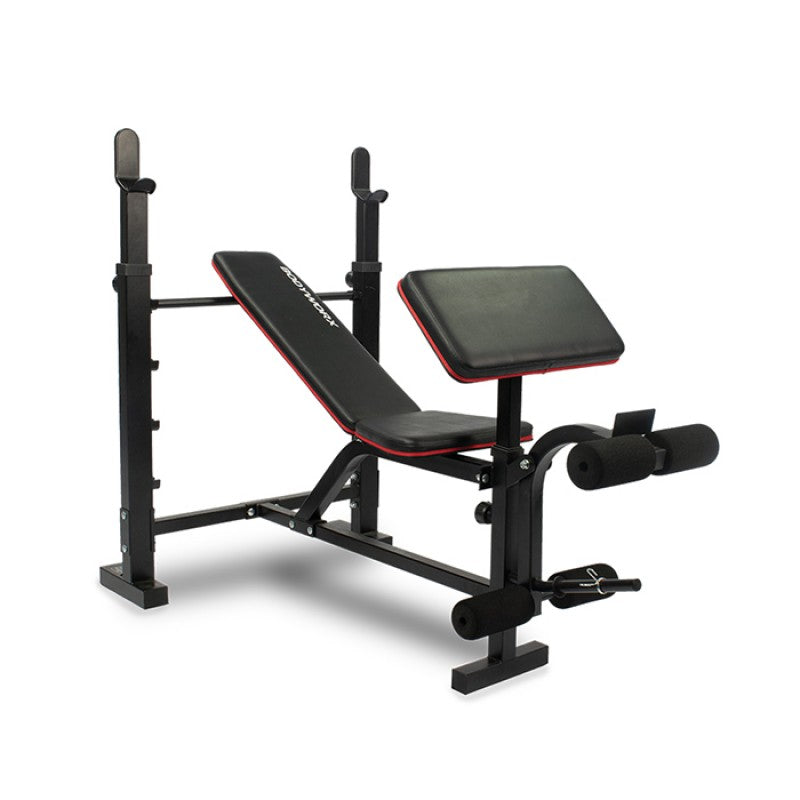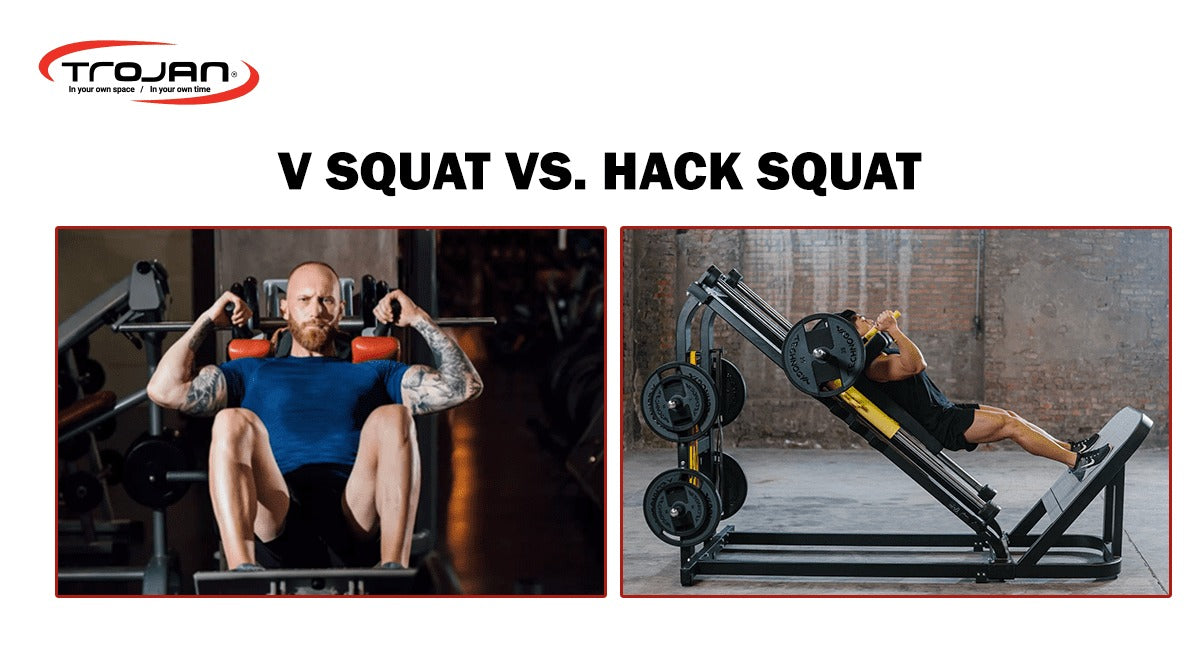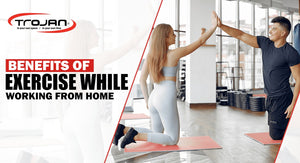Diving into the world of leg workouts can feel like navigating a maze, especially when you're deciding between favourites like the V squat and the Hack squat. At Trojan we get people who are not sure sometimes what the best course of action for them is. Both are champions in their own right, offering unique ways to strengthen and sculpt your lower body.
Ready to find out? Let's get started!
What is a V Squat?
V Squat is also known as the Front Squat, Power Squat, or Super Squat Machine.
It's like having the best parts of different types of squat machines rolled into one. It's designed to make squats feel more natural and safer, especially if you're just starting out or looking to push yourself further. The squat machines are some of the most popular items on Trojan.
The way it's built, with a V-shaped spot for your feet and weights, helps keep everything balanced. This means less strain on your knees, hips, and back, making it a safer option for getting those squats in. So, whether you're a newbie or a pro, the V Squat machine is here to make leg day a good day.
V/Front Squat Complete Guide
Here's a step-by-step guide to getting into the right position for this squat:
- Bar Positioning: Begin by setting the bar at chest level on the rack. Hold it just wider than your shoulders, ensuring the bar touches your upper chest. Your fingers should lightly rest on the bar's bottom, palms up.
- Hand and Arm Placement: Your hands' backs will be against your chest, cradling the barbell.
- Squatting Technique: As you squat, keep your elbows high, push your knees outwards, and make sure your heels stay firmly on the ground.
- Posture: Maintain a neutral spine with your chest and head lifted. Avoid looking down to prevent leaning forward. Straight arms and high elbows will aid in keeping your upper body upright.
- Squat Motion: Focus on descending straight down rather than sitting back. This helps in maintaining balance and prevents you from tipping forward.
Upsides and Problems of V Squats
Before incorporating V squats into your workout routine, it's important to weigh their benefits and disadvantages to make an informed decision.
Upsides of V Squats
V or Front squats offer a range of benefits, from strengthening key muscle groups to improving flexibility and revealing physical imbalances:
- Your core and back muscles get a solid workout as stabilizers, helping to build strength in these areas.
- For those with knee concerns, front squats can be a more comfortable option, offering a way to work out without aggravating knee issues.
- Significantly improves your back squat technique, as it trains your body to maintain proper posture and balance.
- Contribute to the strength of leg muscles, essential for performing other major movements like squats and deadlifts effectively.
- Promotes flexibility in crucial joints, helping in overall mobility and movement efficiency.
-
It highlights areas of weakness that might not be apparent during hack squats or back squats, such as difficulties in keeping the chest up, a weak core, arm mobility issues, or limited ankle flexibility.
Despite these benefits, there are some disadvantages to take into consideration.
Problems of V Squats
V squats can be challenging due to the involvement of various stabilizer muscles, and here's what typically happens:
- Limited Repetitions: The engagement of numerous stabilizer muscles during front squats often means the struggle to perform the exercise correctly over many repetitions. This is especially true for beginners, who might find their form faltering even more quickly.
- Full-Body Endurance: It's not just about having strong legs. Your upper back, core, and forearms also need to have the endurance to maintain proper form throughout the exercise. If any of these areas weaken during the squat, it increases the risk of improper form and potential injury.
- Wrist and Elbow Discomfort: It's common to experience wrist and elbow discomfort during front squats. Considering wrist wraps or adopting a cross-arm grip can help alleviate some of this strain, making the exercise more comfortable.
Hack Squat Complete Guide
Getting ready for the hack squat means prepping your muscles and getting familiar with the machine. At Trojan one of the most popular kinds of machines is the Leg Press 45°Hack Squat + Sissy Squat + HyperExtension Bench
Here's how to start:
- Start by stretching your legs thoroughly. Focus on your quads, hamstrings, glutes, and inner thighs. This step is crucial for preventing injuries, promoting blood flow, and avoiding muscle tears.
- In a hack squat machine, start with no added weight to warm up your legs, then gradually add weight as you feel more comfortable.
- With your back against the machine's pads, position your feet shoulder-width apart. Before you start, release any safety handles, take a deep breath in, and then lower yourself as far down as you can comfortably go. Push down firmly to return to the starting position.
- In the hack squat, the weight is aligned above your shoulders, easing the load on your upper body and focusing the effort on your legs.
- This setup ensures that your legs, especially your quads, are doing the heavy lifting, with less involvement from other muscle groups.
Benefits and Disadvantages of Hack Squats
In this section, we will discuss the benefits and disadvantages of hack squats.
Upsides of Hack Squats
- The hack squat platform elevates the heels above the toes, improving stability and reducing ankle mobility issues often encountered in traditional or V squats.
- Injury prevention is a significant benefit of the hack squat; it removes the need for strong ankle and knee mobility, as well as core and upper back strength, with it's supportive back pad.
- Best for building quads, the hack squat allows for heavy loading without the need to stabilize the body, focusing effort directly on the quads.
- Not just for quads, the hamstrings also get a thorough workout, possibly more so than in back squats, as the hack squat doesn't require body balancing.
- Core engagement is simplified as the body is secured in position, allowing for focused core activation without the balance concerns of traditional squats.
- Mastery in hack squats can enhance performance in other leg exercises, like squats and deadlifts, contributing to overall leg strength and improvement in these lifts.
Problems of Hack Squats
- If limited mobility is a concern, avoid stressing your lumbar spine by not squatting too low, especially if the machine forces your back into a fixed position and you experience pain or discomfort.
- The fixed range of motion in hack squats means your lower back may work harder, especially if you ascend too quickly; maintain slow and controlled movements to mitigate this.
- Those with back or knee pain should approach hack squats with caution; avoid the exercise if it causes discomfort.
Note: Regular stretching and a thorough warm-up before starting can help prevent most issues associated with hack squats.
Hit those muscle targets or mix things up for a well-rounded leg day.
Merging Squat Exercises Into Your Routine
To effectively blend these exercises into your routine, consider the following tips:
Stretching and Warm-up
Performing a proper warm-up and stretching routine before engaging in the hack squat or the V squat can help minimize the risk of injury.
Some suggestions for an effective warm-up include:
Cardiovascular exercises, such as:
- Jogging or Brisk Walking: An easy jog or brisk walk activates the quadriceps, hamstrings, and calves, gradually increasing blood flow and heart rate without overstraining the muscles.
- Jumping Jacks: This full-body movement increases your heart rate while engaging the calves, quadriceps, and glutes as you jump your legs in and out.
- Mountain Climbers: This exercise gets your heart pumping quickly while targeting the quadriceps, hamstrings, and glutes as you alternate driving your knees towards your chest in a plank position.
Dynamic stretching and focusing on the major muscle groups involved in the exercises: quadriceps, hamstrings, glutes, and calves:
- Leg Swings (Front to Back): Targets the hamstrings and quadriceps. Stand on one leg and swing the other leg forward and backward. Increase the range gradually to stretch the muscles thoroughly.
- Side Leg Swings: Focuses on the inner and outer thighs, glutes, and hips. Stand sideways near a wall or a sturdy object for balance, and swing your leg closest to the wall back and forth across the front of your body.
- Walking Lunges: Engages the quadriceps, hamstrings, and glutes. Step forward into a lunge position, lowering your back knee towards the ground while keeping your front knee over the ankle. Alternate legs as you move forward.
- Butt Kicks: Warms up the hamstrings and calves. Jog in place while trying to kick your heels up towards your glutes with each step.
- High Knees: Targets the quadriceps, with some activation of the calves and glutes. Jog in place, lifting your knees as high as possible with each step, aiming for waist height if you can.
Weight Selection
Selecting the right weight is necessary for both the hack squat and the V squat. Begin with a lighter load to master the movements and maintain the correct form. As you get more comfortable and confident with the exercises, slowly up the weight to a level that pushes your muscles but is still safe.
Conclusion
In the battle of V squats vs hack squats, each has its own role,
If you're looking to bulk up, hack squats are your heavyweight champion, letting you lift big without worrying about balance. They're all about getting your quads to do the heavy lifting. At Trojan we have a range of different gym equipment for every kind of body and every kind of goal.
On the other hand, V squats are perfect for strengthening your stabilizer muscles, helping you work on areas that need a bit more attention.
Hack Squats are also very popular with fitness enthusiasts with products like the Trojan PowerPro Power Rack Lat Pulldown Bench Barbell+100 Kg Plates D/Bell Rack + 269 D/Bells and also the Power Rack Cable Cross Lat Pulldown Functional Trainer + Power Pro Leg Press 45°Hack Squat growing in demand day by day.
For the best results, why not use both? Start with hack squats, gradually increasing the weight to build up your leg muscles. At the same time, practice V squats with lighter weights to perfect your form and strengthen those all-important stabilizing muscles.
Adding both exercises to your routine is a smart way to achieve well-rounded lower body strength and fitness.
Disclaimer:
The information provided on this website is intended for general informational purposes only and should not be considered professional or medical advice. We make every effort to ensure the information provided is accurate and up-to-date, but we cannot guarantee the accuracy, completeness, or timeliness of the information. Any reliance you place on such information is strictly at your own risk. Always consult a qualified professional before making any significant changes to your diet, exercise routine, or lifestyle. We are not responsible for any adverse consequences resulting from the use of, or reliance on, any information provided on this website.
 All Payment Methods are Accepted
All Payment Methods are Accepted









